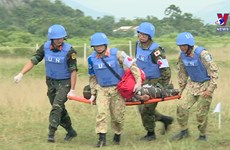WHO’s new therapy cures 36 million TB patients
An estimated 36 million people have been cured of tuberculosis since the World
Health Organisation (WHO) developed the Directly Observed Therapy Short-course
(DOTS) in 1994, according to the WHO’s release on Dec. 9.
An estimated 36 million people have been cured of tuberculosis since the World
Health Organisation (WHO) developed the Directly Observed Therapy Short-course
(DOTS) in 1994, according to the WHO’s release on Dec. 9.
Head of the WHO’s TB Stop Department Mario Raviglione said 15 years of the investment in the new therapy has brought visible results.
Together, national TB programmes, the WHO, the UNAIDS, the Global Fund and other partners have saved 8 million people over the past 15 years.
DOTS has been incorporated into the WHO’s TB Stop Strategy as a main component, and according to the WHO’s latest update, it showed continued progress on addressing the lethal combination of TB and HIV for 1.4 million TB patients tested positive with HIV.
However, the WHO warned the current pace of progress was far from sufficient to meet the target of TB elimination.
In 2008, about 1.8 million people died from the disease, including half a million deaths associated with HIV.
TB is still the second lethal disease after HIV/AIDS.
The WHO’s Director General Margaret Chan stressed the emergent task of preventing multidrug-resistant strains of TB.
Drug resistant strains of the TB bacteria are infecting 500,000 people a year, but only 3 percent of them are receiving treatment. Sixty percent of cases are found in Russia , China , India and Africa .
The health ministers of 27 countries having the highest number of TB patients have agreed upon solutions to prevent TB.
In addition to a pledged donation of 15 billion USD from now to 2015, the WHO has called the international community to contribute 2 billion USD to fill the shortfall in funding for TB treatment in 2010./.
Head of the WHO’s TB Stop Department Mario Raviglione said 15 years of the investment in the new therapy has brought visible results.
Together, national TB programmes, the WHO, the UNAIDS, the Global Fund and other partners have saved 8 million people over the past 15 years.
DOTS has been incorporated into the WHO’s TB Stop Strategy as a main component, and according to the WHO’s latest update, it showed continued progress on addressing the lethal combination of TB and HIV for 1.4 million TB patients tested positive with HIV.
However, the WHO warned the current pace of progress was far from sufficient to meet the target of TB elimination.
In 2008, about 1.8 million people died from the disease, including half a million deaths associated with HIV.
TB is still the second lethal disease after HIV/AIDS.
The WHO’s Director General Margaret Chan stressed the emergent task of preventing multidrug-resistant strains of TB.
Drug resistant strains of the TB bacteria are infecting 500,000 people a year, but only 3 percent of them are receiving treatment. Sixty percent of cases are found in Russia , China , India and Africa .
The health ministers of 27 countries having the highest number of TB patients have agreed upon solutions to prevent TB.
In addition to a pledged donation of 15 billion USD from now to 2015, the WHO has called the international community to contribute 2 billion USD to fill the shortfall in funding for TB treatment in 2010./.













